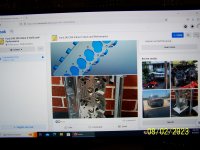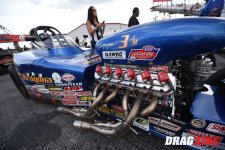Just saw this on another forum. I believe it was posted this morning (on FB) by Eddie Terry. No price set yet. Claims of 500cfm out of the box but not qualified as to whether this was flowed for verification or the CAD software said so. When asked if it had been on an engine the reply was it still needs many other supporting parts. Some they will make, probably others like pistons are TBD. So they have a bare head, no top end stuff, no pistons to match chambers, and no mention if a cam had been proposed. Has not been on an engine because they are not really close (my words, not theirs). Guessing 2 years away, if at all.
You are using an out of date browser. It may not display this or other websites correctly.
You should upgrade or use an alternative browser.
You should upgrade or use an alternative browser.
240 300 crossflow billet head
- Thread starter AllenC
- Start date
aussie7mains
Famous Member
Scammer IMO, 500cfm, dont think so, thats more than ANY head Ive ever heard of.
As questions are being asked, the owner is filling in the blanks. First, the 500cfm out of the box has changed to 500cfm capable. And some of the customer costs are being posted. Here you go. " the head will retail for about 7k with seats and guides, the rocker system will be $2470, the cam will be $813, lifters range from $1211 to $3140, the billet vLve cover with spring oilers is $2683, billet timing cover with belt drive is $2018, billet intake for a turbo application will be $6839....don't forget you have to add your own short block with custom pistons( wiesco and diamond already have the solid model). You will need valves and springs as well....I could go on and on but you see this is a serious piece". This last part about the pistons, its not clear if he is now a designer of pistons or if he simply has supplied Wiseco and Diamond with dome data that they can adapt to their own pistons. If you go N/A looks like you are on you own for an intake. For the turbo application, plan to cough up $24K plus your turbo for his parts.Just saw this on another forum. I believe it was posted this morning (on FB) by Eddie Terry. No price set yet. Claims of 500cfm out of the box but not qualified as to whether this was flowed for verification or the CAD software said so. When asked if it had been on an engine the reply was it still needs many other supporting parts. Some they will make, probably others like pistons are TBD. So they have a bare head, no top end stuff, no pistons to match chambers, and no mention if a cam had been proposed. Has not been on an engine because they are not really close (my words, not theirs). Guessing 2 years away, if at all.
As you can see from the picture, it is still a low profile head and even though the valves are slanted towards the ports, I don't see them as 500 cfm capable.As questions are being asked, the owner is filling in the blanks. First, the 500cfm out of the box has changed to 500cfm capable.
I would like to see them at least do a preliminary flow bench test.
The best aftermarket ported 3rd generation Hemi heads flow close to 400 cfm and they are a very high port head with very little valve to port angle.
Last edited:
Jmustang_65
Well-known member
Eddie said it will cost $9000
dysphagiait will cost $9000
Without water jackets?Eddie said it will cost $9000
Jmustang_65
Well-known member
His comments so I meant 7kWithout water jackets?
“the head will retail for about 7k with seats and guides, the rocker system will be $2470, the cam will be $813, lifters range from $1211 to $3140, the billet vLve cover with spring oilers is $2683, billet timing cover with belt drive is $2018, billet intake for a turbo application will be $6839....don't forget you have to add your own short block with custom pistons( wiesco and diamond already have the solid model). You will need valves and springs as well....I could go on and on but you see this is a serious piece.”
That may be but there is another problem.Those without the money are always the biggest skeptics.
If the head does perform as stated, the block will not work without major modifications.
The cam tunnel needs to be converted to 7 bearings for a 7 bearing camshaft.
The main caps need to be replaced with billet caps that are supported.
The block will need to be filled.
It will also need a billet crankshaft.
Last edited:
It was stated that a stock block would need required modifications to support the billet head and those would be made and available for lower power goals, but the intended end application for the head is an associated billet block. He also mentions port and chamber design is modeled after other billet BBF heads they offer.That may be but there is another problem.
If the head does perform as stated, the block will not work without major modifications.
The cam tunnel needs to be converted to 7 bearings for a 7 bearing camshaft.
The main caps need to be replaced with billet caps that are supported.
The block will need to be filled.
It will also need a billet crankshaft.
THE FRENCHTOWN FLYER
5K+
VIP
Subscriber
Supporter 2023
Supporter 2022
Supporter 2021
Supporter 2020
Supporter 2018
I don't often stray from the BB6 forum to here but I would have to agree. Indeed, others (NHRA Comp Eliminator racers for one) have concluded the same thing - existing factory blocks cannot keep up with the power levels an unconstrained head design can deliver. To that end some have built their own blocks. If you do that you might as well space the bore centers out to 5.000" inches (it$ been done) so big block sized pistons can be used with a shorter stroke to give a more favorable oversquare bore/stroke ratio, to take advantage of the possible extended RPM range. Of course that dictates new crankshaft and camshaft centers. Well, you know where this is headed - a completely new totally redesigned racing style engine that bears about as much resemblence to a STOCK engine as a NASCAR STOCK car or NHRA Pro STOCK car has to a truly STOCK car.... but the intended end application for the head is an associated billet block. He also mentions port and chamber design is modeled after other billet BBF heads they offer.
I can guarantee that a stock block will not sustain power levels predicted through this head, not even NA.
THE FRENCHTOWN FLYER
5K+
VIP
Subscriber
Supporter 2023
Supporter 2022
Supporter 2021
Supporter 2020
Supporter 2018
500 cfm sounds fishy. I believe the theoretical maximum air flow through a pipe at 28” is 146cfm per square inch. Extremely unlikely to reach. Let’s say it’s a very very good design and flows 130cfm/sqin.
500cfm / 130cfm per square inch = 3.846sqin.
Which works out to an intake runner diameter of 2.212” I.D.
So either the spring seats in the picture are massive or the intake port size is not big enough to reach those claims.
500cfm / 130cfm per square inch = 3.846sqin.
Which works out to an intake runner diameter of 2.212” I.D.
So either the spring seats in the picture are massive or the intake port size is not big enough to reach those claims.
My eyes aren't that calibrated.
That billet head wasn't intended for a stock block, so I don't get why everyone cares that it's overkill for one. It could be made to run on a stock block, if someone had a "stock block" class rule and enough $$$$$, which is why they plan on making the parts to do so.
Do v8 guys bitch when billet prostock heads are overkill for their SBF and they'll never run one anyway?
The 300 bore spacing and bore size are too small to flow 500cfm... https://www.mbellc.com/mbe-sb-ford
https://www.mbellc.com/mbe-sb-ford
That billet head wasn't intended for a stock block, so I don't get why everyone cares that it's overkill for one. It could be made to run on a stock block, if someone had a "stock block" class rule and enough $$$$$, which is why they plan on making the parts to do so.
Do v8 guys bitch when billet prostock heads are overkill for their SBF and they'll never run one anyway?
The 300 bore spacing and bore size are too small to flow 500cfm...
I’m with Wes on this.My eyes aren't that calibrated.
That billet head wasn't intended for a stock block, so I don't get why everyone cares that it's overkill for one. It could be made to run on a stock block, if someone had a "stock block" class rule and enough $$$$$, which is why they plan on making the parts to do so.
Do v8 guys bitch when billet prostock heads are overkill for their SBF and they'll never run one anyway?
None of the previous post say anything about the billet 300 head being overkill.
I simply pointed out that a stock block would have to be highly modified to use a head that flows 500 cfm which has been done in the past so not a problem.
The present day CNC capabilities make it easier and more cost affective to do a billet block.
What we are saying is that the head designed as shown will not flow 500 cfm no matter what block it is sitting on and should only have cfm ratings posted after being flow tested on a flow bench.
The MBE SBF head you posted is a raised port design and can be made to flow near 500 cfm.
The billet 300 head as shown in the pics is not a raised port design.
I don't understand why there isn't flow bench test results.
It makes the cfm claims look suspicious.
I've used a set of Australian based Pro Stock SBF billet heads that flowed at least 500 cfm so I know what the ports look like for that type of performance in a small block head.
Last edited:
THE FRENCHTOWN FLYER
5K+
VIP
Subscriber
Supporter 2023
Supporter 2022
Supporter 2021
Supporter 2020
Supporter 2018
"Intake Valve Diameter: 2.320
Exhaust Valve Diameter: 1.585"
I find it interesting that the small 1.585 exhaust valve is sufficient to support a 2.3" intake valve. I say this because when I picked up my crossflow head from being ported and flowed at Jerry Arnold Cylinder Heads he put a smallish 1.55" exhaust valve in it. I was surprised but he said the 1.55 would be all I needed. Subsequent discussions I had with other head port authorities confirmed that decision. What is important is how much the exhaust port flows at low lift, where the preponderance of massflow takes place upon opening, and where upon closing that high flow rate aids scavenging.
I no longer put much credence in the "desired flow ratios" between intake and exhaust max flow numbers.
Exhaust Valve Diameter: 1.585"
I find it interesting that the small 1.585 exhaust valve is sufficient to support a 2.3" intake valve. I say this because when I picked up my crossflow head from being ported and flowed at Jerry Arnold Cylinder Heads he put a smallish 1.55" exhaust valve in it. I was surprised but he said the 1.55 would be all I needed. Subsequent discussions I had with other head port authorities confirmed that decision. What is important is how much the exhaust port flows at low lift, where the preponderance of massflow takes place upon opening, and where upon closing that high flow rate aids scavenging.
I no longer put much credence in the "desired flow ratios" between intake and exhaust max flow numbers.
I'm sorry, it wasn't directed at you, this thread just got off to a bad start from the beginning, in my opinion, and it won't let me edit it.I’ll let you rephrase that statement.
Show me the time slip, to me everything else is just BS.



